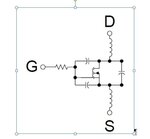zuq
Member level 3
How can I find the Miller charge for a MOSFET under drain to source voltages other than testing conditions. This is for a synchronous rectifier MOSFET, clamped at 1.3V.. IRF4004PBF MOSFET
Also, probably a stupid question, but just want to make sure; Does the internal resistance of MOSFET gate affect its switching speed?
Thanks
Also, probably a stupid question, but just want to make sure; Does the internal resistance of MOSFET gate affect its switching speed?
Thanks
